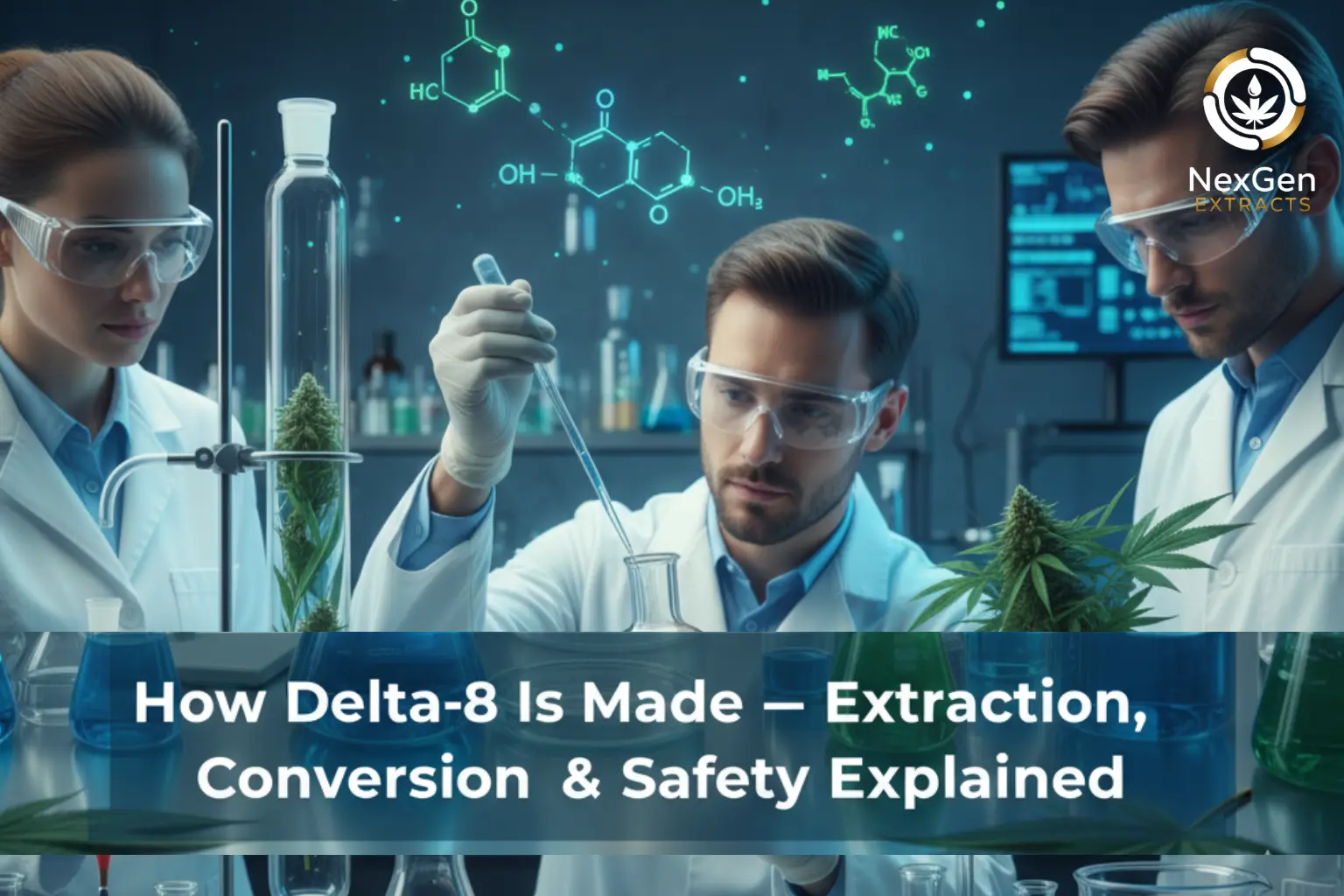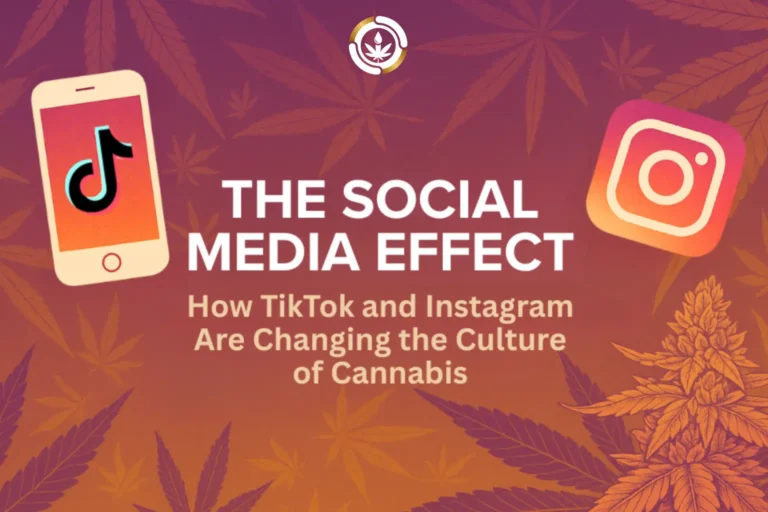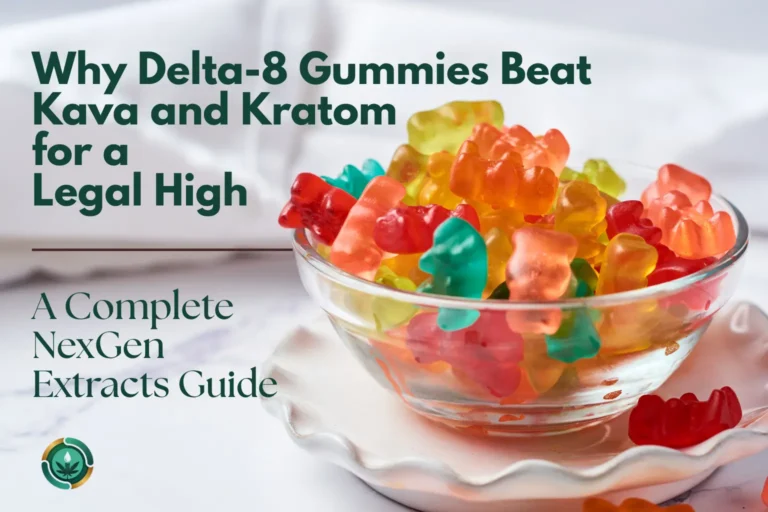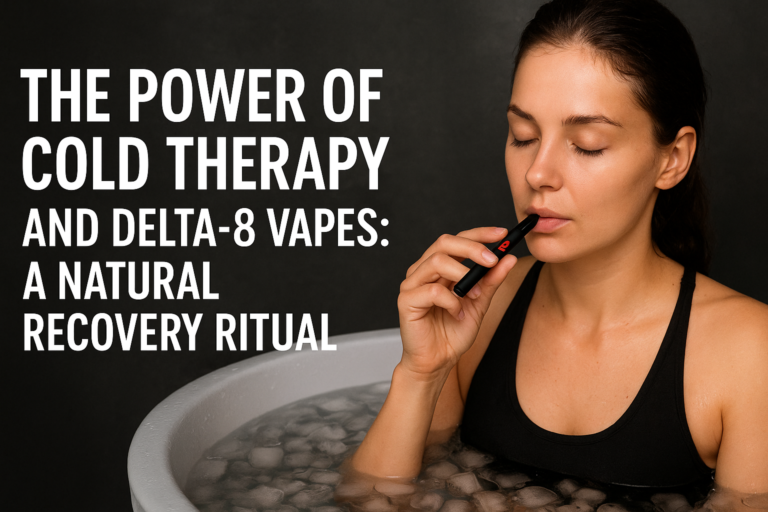
Introduction: The Rise of Delta-8 THC in America
Delta-8 THC has exploded in popularity across the United States. From Delta-8 Gummies to vape carts and tinctures, this compound is now sold almost everywhere — gas stations, smoke shops, and wellness stores.
But the growing buzz around Delta-8 also comes with confusion. Many consumers ask: Is Delta-8 natural or synthetic? How exactly is it made? And is it safe to consume?
This guide from NexGen Extracts breaks down the science, extraction process, legal framework, and safety facts behind Delta-8 THC. It’s written to help you understand not only where Delta-8 comes from — but also how to choose trustworthy products in a fast-changing market.
What Exactly Is Delta-8 THC?
Delta-8 THC, or Delta-8-tetrahydrocannabinol, is a cannabinoid found naturally in the hemp plant. Chemically, it’s a close cousin of Delta-9 THC, the psychoactive compound in marijuana.
While Delta-9 is famous for causing a strong “high,” Delta-8 delivers milder, smoother effects — often described as more clear-headed and relaxing.
However, there’s one big difference: Delta-8 occurs in very small amounts in natural hemp. Because it’s so rare, most of the Delta-8 in consumer products today is converted from CBD through a lab process.
How Delta-8 THC Is Made: The Conversion Process
Delta-8 THC is usually made by converting CBD (cannabidiol) extracted from legal hemp into Delta-8 molecules using controlled chemistry.
Let’s break down the major steps in that process:
Step 1: Hemp Cultivation and CBD Extraction
The process starts with hemp cultivation, grown under the guidelines of the 2018 U.S. Farm Bill, which legalized hemp containing less than 0.3% Delta-9 THC.
Producers then extract CBD oil from hemp using CO₂ extraction or ethanol extraction. These methods separate cannabinoids, terpenes, and plant waxes, producing a clean CBD concentrate.
This CBD extract becomes the base ingredient for Delta-8 production.
Step 2: Isomerization (The Chemical Conversion)
Since Delta-8 and CBD share almost identical chemical structures, they can be converted through a process called isomerization.
Here’s how it works in simple terms:
- Chemists dissolve CBD in a solvent, usually heptane or toluene.
- Then they add a small amount of acid — often p-toluenesulfonic acid or hydrochloric acid — as a catalyst.
- The mixture is gently heated for several hours.
- The acid rearranges the molecular bonds of CBD, turning it into Delta-8 THC.
Afterward, the solution is neutralized, washed, and distilled to remove impurities.
The goal is to create a pure Delta-8 distillate that meets laboratory purity standards.
Step 3: Distillation and Refinement
After conversion, the crude Delta-8 mixture goes through short-path distillation or chromatography.
These refining steps remove solvents, residual acids, and unwanted byproducts. The result is a golden, viscous Delta-8 oil that can be used in different products — such as Delta-8 Gummies or vape cartridges.
This step is critical for safety. Poorly refined Delta-8 can contain harmful residues, which is why third-party testing is essential before products reach the market.
Step 4: Infusing Delta-8 Into Consumer Products
Once purified, Delta-8 distillate can be used in:
- Delta-8 Gummies (for edible dosing)
- Delta-8 Oil tinctures (for sublingual use)
- Vape cartridges (for inhalation)
- Softgels or capsules (for controlled dosing)
Each form offers a different experience, depending on the user’s preference and tolerance.
Is Delta-8 Synthetic? The Ongoing Debate
The answer depends on how you define “synthetic.”
Technically, Delta-8 is a naturally occurring cannabinoid. However, because nearly all Delta-8 in the market is chemically converted from CBD, some scientists and regulators call it “semi-synthetic.”
Here’s how it compares:
- Natural extraction = Delta-8 directly from hemp (extremely rare and expensive).
- Conversion-based Delta-8 = derived from hemp-based CBD via chemical transformation.
So, while it’s hemp-derived and legal under federal law, it’s still lab-made — not directly extracted from the plant in large amounts.
Safety Concerns Around Delta-8 THC
The biggest concern isn’t Delta-8 itself — it’s how it’s made.
Because the conversion process involves acids and solvents, unqualified producers may leave behind contaminants. This is especially risky when products aren’t properly refined or tested.
1. Residual Solvents
Low-quality manufacturing can leave traces of solvents like heptane or toluene. These chemicals are toxic if inhaled or ingested.
Always check a product’s Certificate of Analysis (COA) for solvent-free results.
2. Heavy Metals and Impurities
Improper distillation can lead to heavy metal contamination from lab equipment. Common culprits include lead, arsenic, and cadmium.
Third-party labs test for these impurities, but not every manufacturer provides transparent reports.
3. Unregulated Production
Because the FDA doesn’t regulate Delta-8 products, safety standards vary widely.
Some brands test every batch; others skip it entirely. This lack of oversight allows mislabeling — such as inaccurate THC content or hidden contaminants — to slip through.
4. Misleading Dosages
Labels can also be deceptive. One gummy may claim “25 mg Delta-8,” but without testing, it could contain much more or less.
Inconsistent dosing leads to unpredictable experiences — from mild relaxation to strong psychoactive effects.
Comparing Delta-8 THC With Other Cannabinoids
To understand Delta-8’s appeal, let’s compare it with other common cannabinoids.
Delta-8 vs. Delta-9 THC
- Delta-8 THC produces a lighter, smoother high.
- Delta-9 THC (found in marijuana) is stronger and often more anxiety-inducing.
- Delta-8 is federally legal when hemp-derived; Delta-9 above 0.3% remains federally restricted.
For many, Delta-8 Gummies or Delta-8 Oil offer a middle ground between CBD calmness and Delta-9 intensity.
Delta-8 vs. CBD
- CBD is non-intoxicating and used mainly for relaxation or inflammation.
- Delta-8 THC provides euphoria, mild stimulation, and body calmness.
- Both are legal under federal hemp laws when properly sourced.
Some users combine CBD and Delta-8 for balanced effects — reducing anxiety while maintaining focus.
The U.S. Legal Status of Delta-8 THC
Delta-8 THC’s legality depends on how it’s made and where you live.
Federal Law
Under the 2018 Farm Bill, hemp and its derivatives are legal if they contain less than 0.3% Delta-9 THC.
Because Delta-8 is made from hemp-derived CBD, it’s technically legal at the federal level.
However, the DEA classifies “synthetically derived” THC as controlled. Since Delta-8 is made through chemical conversion, its legal status remains ambiguous.
State Laws
Several states — including Colorado, New York, and Alaska — have banned Delta-8 sales outright. Others have introduced regulations requiring lab testing and age restrictions.
Always check your state’s hemp laws before buying or shipping Delta-8 products.
Why Purity Testing Matters
Third-party lab testing is the single most important factor in identifying safe Delta-8 products.
A proper COA (Certificate of Analysis) should include:
- Cannabinoid profile (showing Delta-8 potency)
- Residual solvent analysis
- Heavy metal testing
- Microbial contamination check
If a brand can’t provide these results, avoid their products. Transparency builds trust — and protects your health.
Choosing Safe Delta-8 Gummies or Oils
If you’re considering trying Delta-8, use this checklist to choose responsibly:
✅ Check COAs: Only buy from brands with published third-party lab reports.
✅ Avoid “cheap” Delta-8: Quality extraction costs money; low prices often signal poor safety standards.
✅ Look for transparent sourcing: Reputable brands disclose their hemp origin and conversion methods.
✅ Understand your tolerance: Start with 5–10 mg per dose and observe effects.
✅ Store properly: Keep Delta-8 Oil and gummies in a cool, dark place to preserve potency.
How Delta-8 Affects the Body
Delta-8 binds to the CB1 receptors in the brain and nervous system, similar to Delta-9, but with less affinity.
This means users experience:
- Mild euphoria
- Relaxed focus
- Reduced anxiety
- Pain relief
- Improved sleep
Because it’s less potent, many people prefer Delta-8 for gentle evening use or stress relief — especially in edible form like Delta-8 Gummies.
Side Effects to Watch For
Though generally milder than Delta-9, Delta-8 can still cause:
- Dry mouth
- Drowsiness
- Red eyes
- Mild anxiety or confusion (at high doses)
Always start small and avoid combining Delta-8 with alcohol or sedatives.
Regulatory and Safety Outlook
The U.S. hemp industry is evolving rapidly. By 2025, lawmakers are expected to introduce new cannabinoid labeling standards.
These may include:
- Mandatory lab certification
- Clear dosage instructions
- Age restrictions (21+)
- QR code traceability for product batches
For now, consumer awareness remains the best safety tool. Knowing how Delta-8 is made — and from whom — protects users and strengthens the credibility of the hemp industry.
Future of Delta-8: Between Innovation and Oversight
Delta-8 THC reflects a larger trend: turning hemp’s chemical potential into innovative, legal wellness products.
When manufactured responsibly, it offers a bridge between CBD calmness and Delta-9’s recreational euphoria.
However, until regulation catches up, buyer education and lab transparency will determine whether Delta-8 becomes a trusted wellness tool — or another cautionary tale of unregulated chemistry.
Final Thoughts
Delta-8 THC isn’t inherently dangerous — but how it’s made matters.
High-quality Delta-8 Oil and Gummies come from clean hemp, careful conversion, and rigorous testing. Low-quality products, on the other hand, can contain residual solvents or mislabeled potency.
At NexGen Extracts, our goal is simple: help readers make informed choices about hemp and cannabinoids.
So next time you see a shiny Delta-8 label, remember the chemistry behind it. Choose transparency. Ask for COAs. And prioritize your safety — because education is the strongest protection consumers have in the world of cannabinoids.



